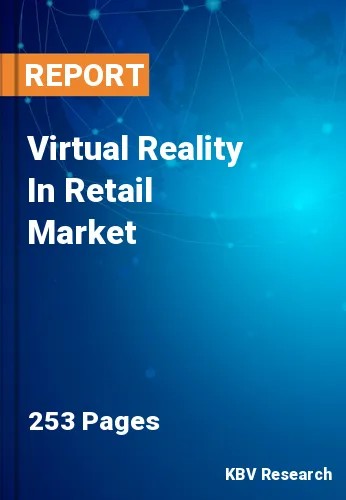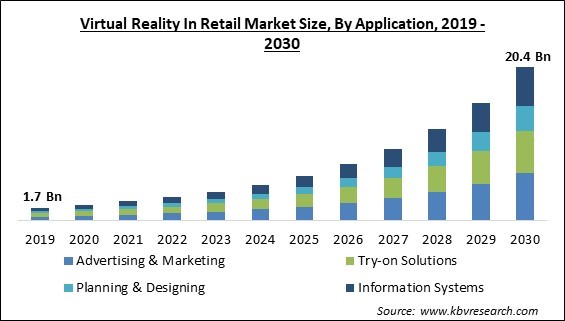
The Global Virtual Reality In Retail Market size is expected to reach $20.4 billion by 2030, rising at a market growth of 26.9% CAGR during the forecast period.
Europe is one of the promising regions in Virtual Reality in Retail because of the existence of several renowned fashion companies that are utilizing virtual reality to improve the consumer experience and expand their brand awareness. Thereby, Europe captured $954.3 million revenue in the market in 2022. Additionally, the increasing preference for online shopping, which offers customers individualized shopping experiences and access to a wide range of products. For example, one of Europe's largest e-commerce markets is Germany. Total sales increased 24 percent over 2020 to USD 127.5 billion in 2021. Germany's internet users are predicted to increase from 62.4 million in 2020 to 68.4 million in 2025. Some of the factors impacting the market are growing smartphone penetration, expansion of e-commerce sector, and easier said than done: omnichannel VR.

The smartphone usage has surged significantly over the past few years. The International Telecommunication Union (ITU) anticipates that by February 2021, 6.5 billion among 7 billion people will have access to a mobile phone. As a result, rising smartphone penetration has resulted in rising adoption of VR technologies in retail sector, leading to market growth. The use of smartphones is expanding globally, and internet usage has also become more prevalent. Adopting 4G and 5G communication technologies will positively affect the e-commerce sector. The trend of Internet shopping has grown rapidly in recent years. This will eventually offer significant prospects for market.
However, the store of the future will be a hybrid of the digital and physical worlds, combining the advantages of e-commerce in terms of ease with those of brick and mortar in terms of product research. Traditional retailers have recognized the value of digital merchandising and the influence of a first impression online. Considering these aspects collectively, the market may witness slow growth during the projection period.
On the basis of component, the market is segmented into hardware, software, and services. In 2022, the hardware segment held the highest revenue share in the market. The development of headsets with a notable emphasis on display resolution, comfort, and overall performance. Additionally, eye-tracking technology will allow for gathering insightful consumer data, and gesture and motion tracking will improve user interaction. The requirement for scalable and cheap VR solutions to serve a wider range of retail stores and customers is another factor pushing innovation in the market's hardware which would eventually support the segment’s expansion.

Based on device, the market is classified into head mounted devices, gesture tracking device, and projectors & display wall. In 2022, the head mounted devices segment dominated the market with the maximum revenue share. The consumer demand for VR headsets like the Oculus Rift, HTC Vive, and PlayStation VR is driving the segment's expansion. For different retail applications, such as virtual product demos, virtual try-on, and virtual store visits, these headsets offer immersive experiences and are frequently used by various retail stores. Demand for HMDs is predicted to increase as prices decline and technology improves, enhancing the segment's position as a significant revenue source for the market.
By application, the market is categorized into information systems, advertising & marketing, try-on solutions, and planning & designing. The planning & designing segment covered a considerable revenue share in the market in 2022. This is because of the benefits virtual reality offers the retail sector, including visual advertising, store prototypes, and store design & layout. Additionally, before applying virtual shop layouts & designs in actual spaces, retailers can view and build them using VR technology. They can also use virtual reality to experiment with product placement, shelving configurations, and design changes, which is anticipated to further propel the market growth over the coming years.
Based on the vertical, the market is fragmented into food & beverage, home products, clothing, and consumer electronics. In 2022, the food & beverages segment projected a prominent revenue share in the market. Customers may explore menus, engage with virtual waitstaff, and immerse themselves in virtual restaurant environments. This development improves the whole eating experience and drives the development of VR in the food & beverage retail sector. Customers can use this trend to preview and experience dining alternatives before making reservations or placing food orders.
| Report Attribute | Details |
|---|---|
| Market size value in 2022 | USD 3.1 Billion |
| Market size forecast in 2030 | USD 20.4 Billion |
| Base Year | 2022 |
| Historical Period | 2019 to 2021 |
| Forecast Period | 2023 to 2030 |
| Revenue Growth Rate | CAGR of 26.9% from 2023 to 2030 |
| Number of Pages | 253 |
| Number of Table | 460 |
| Report coverage | Market Trends, Revenue Estimation and Forecast, Segmentation Analysis, Regional and Country Breakdown, Companies Strategic Developments, Company Profiling |
| Segments covered | Component, Device, Application, Vertical, Region |
| Country scope | US, Canada, Mexico, Germany, UK, France, Russia, Spain, Italy, China, Japan, India, South Korea, Singapore, Malaysia, Brazil, Argentina, UAE, Saudi Arabia, South Africa, Nigeria |
| Growth Drivers |
|
| Restraints |
|
Region wise, the market is analyzed across North America, Europe, Asia Pacific, and LAMEA. In 2022, the North America region witnessed the largest revenue share in the market. This has been attributed to the region's rising digitalization and advancements in virtual reality technology. Additionally, the region's market growth is anticipated to be fueled by high levels of disposable income and falling prices for headsets with screens and processors. Also, the increased competition among stores in the region and the growing need for better customer purchasing experiences are anticipated to fuel the expansion of virtual reality in the retail market.
Free Valuable Insights: Global Virtual Reality In Retail Market size to reach USD 20.4 Billion by 2030
The market research report covers the analysis of key stake holders of the market. Key companies profiled in the report include Matterport, Inc., Scapic Innovations Private Limited (Flipkart Pvt. Ltd,) (Walmart Inc.), FXGear, Inc., Visualise Creative Limited, Panedia Pty Ltd., FireBird VR, KonceptVR LLC, WeMakeVR, Fiebak Medien, and Subvrsive, Inc.
By Application
By Component
By Device
By Vertical
By Geography
The Market size is projected to reach USD 20.4 billion by 2030.
Expansion of e-commerce sector are driving the Market in coming years, however, Easier said than done: omnichannel VR restraints the growth of the Market.
Matterport, Inc., Scapic Innovations Private Limited (Flipkart Pvt. Ltd,) (Walmart Inc.), FXGear, Inc., Visualise Creative Limited, Panedia Pty Ltd., FireBird VR, KonceptVR LLC, WeMakeVR, Fiebak Medien, and Subvrsive, Inc.
The Clothing segment is generating the highest revenue share in the Global Virtual Reality In Retail Market by Vertical in 2022 thereby, achieving a market value of $6.3 billion by 2030.
The Advertising & Marketing segment is leading the Global Virtual Reality In Retail Market by Application in 2022 thereby, achieving a market value of $6.3 billion by 2030.
The North America market dominated the Global Virtual Reality In Retail Market by Region in 2022, and would continue to be a dominant market till 2030; thereby, achieving a market value of $7.1 billion by 2030.
Our team of dedicated experts can provide you with attractive expansion opportunities for your business.
